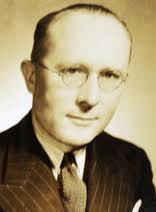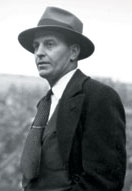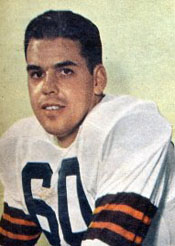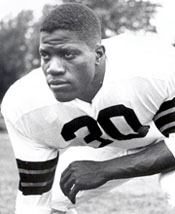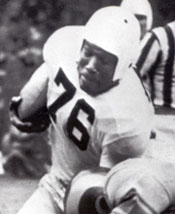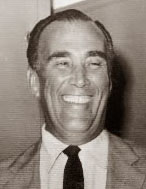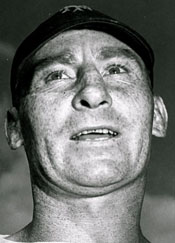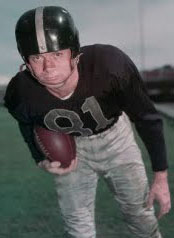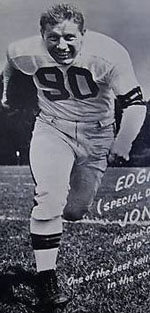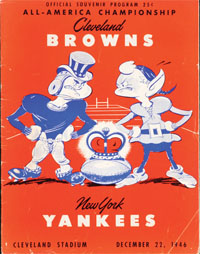Note: The gray boxes contain asides that provide interesting material but could be skipped without losing the continuity of the article.
|
|
The All-America Football Conference played its first season in 1946. Why did this league endure for four years until some of its teams merged into the NFL when earlier leagues had failed?
So the lineup of franchises for the AAFC for its maiden voyage looked like this.
The transfer of an NFL franchise before the '46 season benefitted one AAFC franchise and harmed another.
Not surprisingly for a league conceived by a Chicago sportswriter, the AAFC had a strong Notre Dame influence. Seventeen of the original players were former Fighting Irish. In addition, 49ers coach Buck Shaw was an alum, as was the commissioner, Jim Crowley. Jim and his NFL counterpart, Elmer Layden, had been two of Knute Rockne's famed Four Horsemen of the 1920s. However, Layden's term didn't last much longer. The NFL selected Eagles owner Bert Bell to replace the ineffective Layden in January 1946.
It didn't take long to determine the AAFC's best and worst franchises.
At the opposite end of the spectrum were the Cleveland Browns.
Brown ruled his team with an iron hand. His QB, Otto Graham, recalled: When Paul started in pro football, the image of the players was that of fat bellies, big cigars, foul mouths, and hard drinking. Paul would tell us that we were the New York Yankees of pro football. No drinking. No smoking. No swearing. No getting in trouble. Wear sport coats and ties in public. He really did trade players who were drunks and chased women.
The team captain for 1946 was T Jim Daniell, who played at Ohio State just before Brown took over there. Graham: Daniell ... went out on the town. He'd had a few drinks, then pulled up his car behind a police car. I don't know about you, but when I'm behind a police car, I don't honk the horn and tell the guy to get out of the way - but Jim did. ... there was a confrontation. The policeman took Jim to the station. Jim said he wasn't drunk and demanded a sobriety test. They gave him one, and he'd had enough alcohol to be considered legally drunk, and he was arrested. Brown read the police report in the newspaper the next day and immediately dismissed his captain from the team. If the other players didn't take their coach's rules seriously before, they did now. (Daniell's dismissal reduced the number of former Buckeyes on the Browns to six.) The Browns opened the season with seven straight wins.
In the East, the Yankees had the division sewed up halfway through the season since the other three teams, Buffalo, Brooklyn, and Miami, had a combined nine wins, six of which came against each other.
So the Browns would have to defeat the Yankees a third time to win the league championship.
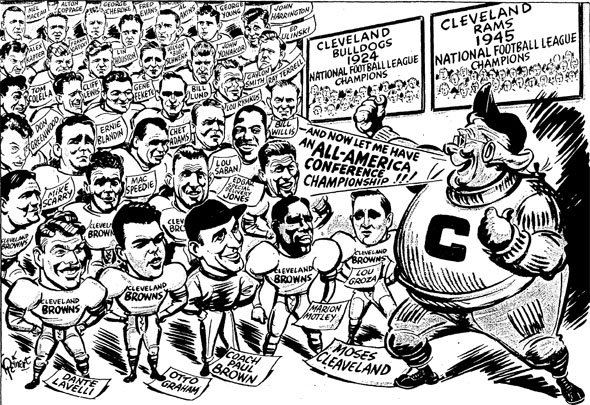 Cartoon in Cleveland Plain Dealer day of championship game Cleveland Municipal Stadium hosted its second pro championship game in as many years.
|
|
|
- The temperature prediction for Sunday, December 22 was right on target but not the clear skies. Fine, wet flakes of snow drifted lazily into the stands during most of the game, and a damp wind off the lake penetrated every corner of the horseshoe.
- Snow from earlier in the week was piled along the sidelines. Some sections of the field were muddy because of melted snow.
- The weather kept the crowd down to 40,469, the second smallest of the season in Cleveland. But that figure still topped the '45 title game attendance of 32,178. The crowd was inflated by 4,000 high school youngsters admitted for 25 cents each.
- A Cleveland Plain Dealer reporter described the overwhelmingly masculine audience like this: It was a young crowd, a crowd dressed in G.I. hoods and parkas, in hunting caps and olive-drab mufflers, in combat boots and four-buckle antics, wrapped in army blankets and gay plaids. Many were obviously home from school for the holidays and in a holiday mood.
- Two Notre Dame players occupied ringside seats for the contest. QB Johnny Lujack and E Jack Zilly sat on the Cleveland bench attired in their Sunday-best clothes. Drafted by the Chicago Rockets, Lujack said he would not play pro ball until 1948 when his college eligibility ended.
Those who braved the elements were rewarded with what many regarded as the best contest of the season, one that went down to the final minutes.
- Quarter 1
The Browns took the kickoff but were thwarted by a former Clevelander. Prokop, who attended Cathedral Latin High School, intercepted Graham's second pass of the day. The former Georgia Tech star returned the ball from midfield to the 34.
Sanders tried the line but failed to gain, then threw a pass toward John Russell, but it was knocked down by Greenwood. Playing in his last pro game before retirement, Parker entered at this point, and, on his first try, fired a pass to Russell that gained 15 to the 19. Sanders then took a lateral from Lloyd Cheatham and whirled around LE for 12 and a first-and-goal. But the Browns stiffened and, after three plays netted only 3y, Harvey Johnson booted an 11y field goal, his sixth straight, to put NY in front 3-0.
The Browns roared back. On the first play after the kickoff return to the 18, Graham lobbed a screen pass to Jones, who pranced all the way to the end zone. But officials ruled he stepped out on his own 35 for only a 17y gain. Passes from Graham to Speedie and Lavelli were instrumental in moving the ball to the 3. But the Yankee D emulated their Brown counterparts, holding three times. Brown decided to go for it on fourth down, but the Yanks sacked Graham for a 13y loss.
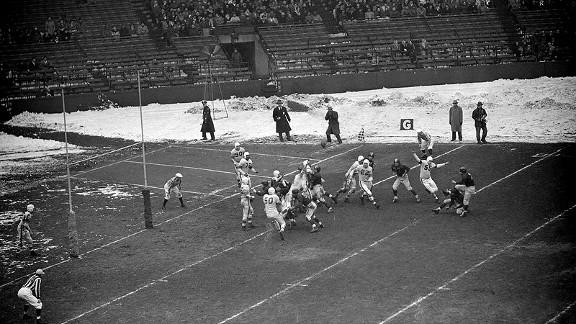
Harvey Johnson boots an 11y field goal to put the Yankees ahead 3-0.
- Quarter 2
Graham returned Parker's punt 13y to the 30. Otto then completed seven consecutive passes, to Jones for 4, Speedie for 8, 9, and 15, and to Lavelli for 18 to move to the 13. Then Motley shot through the C to the 1 and went over on the next snap to give the Browns the lead 7-3 after Groza's PAT.
The Yanks couldn't produce a threat in the final two minutes before halftime.
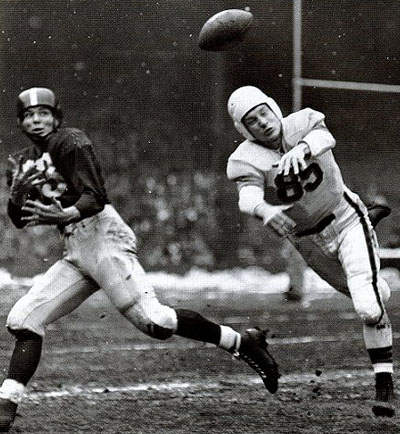
Don Greenwood breaks up a pass intended for Jack Russell.
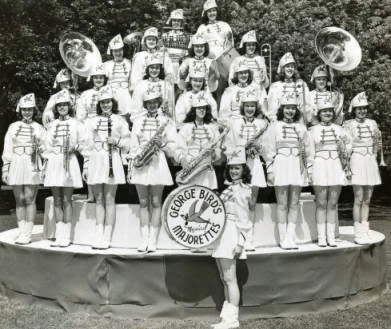
- Quarter 3
Russell gathered in a pass from Parker but fumbled, John Yonakor pouncing on the leather for Cleveland at the NY 36. But three plays gained only 6y. So Groza, playing on a sprained ankle, tried a field goal from the 42 that was wide.
The Yankees took the ball on their 20 and marched downfield to retake the lead. Under a strong rush most of the game, Parker had his only spell of accurate passing on this drive, which started with a toss to Russell for 17. The same combination struck on the next play for 21y to the Cleveland 42. Sanders then made 11y off tackle, and the Yankees got a gift of 5 more when the Browns were caught for defensive holding. Sanders added 6, and Parker threw in 7 to put the ball on the 13. Then Ace fired a hook pass to Russell for 2. Parker smashed through the line for 6 to the 5. Sanders toted the pigskin twice, punching in from the 2 on the second try. Johnson's streak of 36 extra points ended with his first miss of the season. New York 9 Cleveland 7.
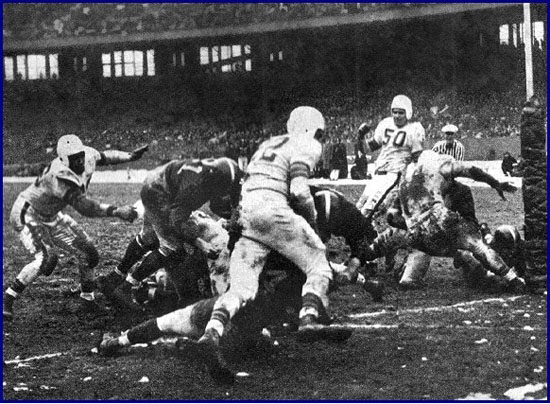
Spec Sanders scores on a 2y run in Q3.
- Quarter 4
But the home team got another break a few minutes later when John Harrington partially blocked Parker's punt to give the Browns possession at the NY 32. But again they failed to advance. So Brown sent in Chet Adams to try a field goal, but he missed also. With a little over eight minutes to play, you couldn't blame fans for thinking this might not be the Browns' day.
Starting from their 20 after the missed field goal, the Yanks gave the ball to Sanders, who broke away for 25y. But on third down, Parker got off a punt that set the Browns back to their 24.
Frustrated because they had outgained the Yankees by a large margin and racked up more first downs but facing possibly their last possession if they failed to score, the Browns started by giving the ball to Motley, who ripped off 10. Jones picked up 1y, then Graham tried a screen pass to Motley that fell incomplete. 3rd-and-nine on your 35 trailing by two calls for a special play. Graham took to the air and, finding Speedie and Lavelli covered, fired the ball to HB Edgar Jones streaking across the middle. Special Delivery scooped up the ball at his shoe tops and fell to the ground. The 24y gain moved the ball to the NY 42. Continuing to mix his plays, Graham called for a reverse, Lavelli throwing forward to Greenwood for eight. Jones slipped off LT for seven and a first down at the 27. Tommy Colella made another first down when he took Graham's lateral and ran around RE for 11 to the 16. Otto then called for the same play that had produced the only TD in the 7-0 victory on a rainy night in Yankee Stadium in October. Known for running precise patterns, Lavelli started straight down, then cut to his right, and headed for the corner of the field. Graham hit him on the six just out of the reach of Prokop's diving effort, and Dante carried the ball and two Yankees into the end zone. Groza's boot made it 14-9 with 4:13 on the clock.
But hold the phone. The New Yorkers started to move until Graham, inserted at safety in the prevent defense, jumped between a pair of receivers with such fury that he lost part of his shirt but came down with Parker's desperation pass to clinch the championship.
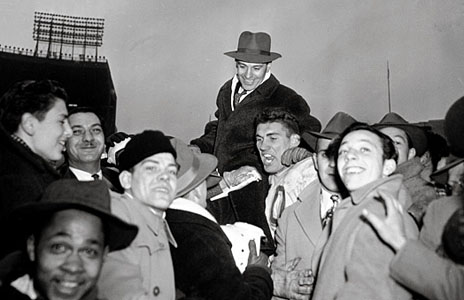
Jubilant Browns carry their coach off the field.
- Jubilant Browns became "Paul-bearers" when they carried their coach off the field on their shoulders after intercepting him as he walked across the field to shake hands with Ray Flaherty.
- After fighting their way through the mob, Brown and his players darted up the ramp and stormed into the dressing room.
- Headgears, pads, and soiled jerseys were hurled to all parts of the room. Someone yelled, "We did it!"
- Owner Arthur McBride warmly congratulatd Brown and each of the players. McBride gave his coach a brand new car that Paul would use to drive his family for a vacation in Miami, where he would watch the Orange Bowl.
- First downs: Browns 18 Yankees 10
- Yards rushing: Browns 37-112 ,Yankees 29-65
- Passing: Browns 16-27-1/213, Yankees 8-20-1/81
- Fumbles-Lost: Browns 3-0, Yankees 2-1
- Penalties: Browns 5-25, Yankees 4-20
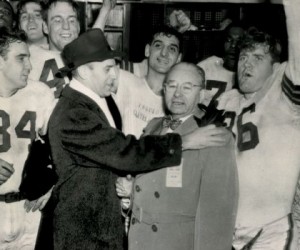
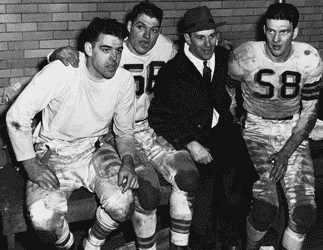
L: Coach Brown and owner McBride celebrate with their players. R: Graham, Lavelli, Brown, and Speedie.
- Brown: Worried? You bet I was worried! I didn't stop worrying until it was all over, and then I worried that I might not get off the field in one piece. ... They all were great - played a marvelous game. It was really a team triumph. Of course, we missed a lot of opportunities. Groza's injury could have cost us the game, but the strategy of short bullet passes when the Yankees were expecting long ones finally paid off.
Concerning Graham, Speedie, and Lavelli, Brown said, I wouldn't trade these three boys for any six football players in the world. Otto was sharp today. I think he played the best game of his career, and that goes a long way. Lavelli had two men on him all afternoon and still caught the ball somehow. And Speedie makes catches that I don't see how he can possibly get. ... It's great to be champion in your first whirl at this professional game. - When Graham pulled off the remaining shreds of his jersey, he revealed an egg-shaped bump where, he said, opposing linemen were rapping him after each pass. He gave credit for his 16 completions (out of 27 attempts) to Lavelli and Speedie. All I do is throw the ball. When you have ends like that, it's simple.
- Motley, who gained 98y on 13 carries, displayed bruises all about his face and arms. I'd like to meet up with one of them boys again. Somebody hit me on the chin, and it really did hurt. I took the ball on the next play, headed for the same spot, and looked for that fellow, but he wasn't there. He was referring to the play on which he sprinted 51y.
- Lavelli complained that he had trouble all afternoon trying to shake Eddie Prokop off my tail. I knew he was right behind me on that touchdown pass from Otto. I turned and found the pass practically in my arms, then looked around and saw the diagonal stripe of the end zone. I thought, "Gosh, will I ever make it before Prokop gets me?" I think I must have said a few prayers.
- Browns captain Lou Saban explained why the Browns had extra motivation on the winning drive. Most of us had spent our championship bonuses already on new cars and other things.
- Browns assistant coach Fritz Heisler wore a forlorn look. Asked whether he was sorry it was over, he replied, Yes, it's been a lot of fun. I wish we were just starting out again.
- Deposed captain Daniell was one of the first visitors to reach the locker room to congratulate his former teammates and thank them for voting him a full share of the proceeds.
- Flaherty: It just wasn't our day again. The outcome may have been different had the field been dry. As it was, neither Sanders nor Prokop could break loose. Prokop gambled on the touchdown pass and lost. He had a choice of either going for the ball or hitting Lavelli after he made the catch. He took a chance on reaching the ball and just missed. We certainly didn't get the breaks today.
The AAFC rewarded the two teams in the title game the same way the NFL did.
- The players split $60,551.32 from the receipts, which included $5,000 for radio rights.
- The victors divvied up 60% of that or $931.57 per man.
- The Yankees drew $645.88 each.
When All the World Was Browns Town, Terry Pluto (1997)
Paul Brown: The Rise and Fall and Rise Again of Football's Most Innovative Coach, Andrew O'Toole (2008)
Top of Page
